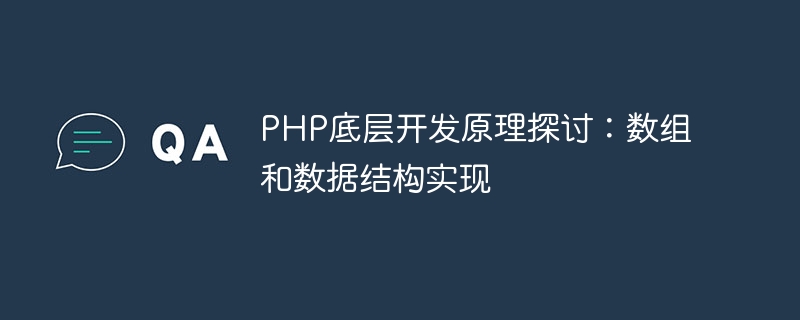Home >Backend Development >PHP Tutorial >Discussion on the underlying development principles of PHP: array and data structure implementation
Discussion on the underlying development principles of PHP: array and data structure implementation
- PHPzOriginal
- 2023-09-10 11:30:41696browse

As a widely used scripting language, PHP’s underlying development principles have attracted much attention. In this article, we will explore the implementation principles of arrays and data structures in PHP.
First, let us understand the basic concepts and usage of arrays in PHP. An array is a data structure used to store multiple values. In PHP, you can use arrays to store different types of values, such as integers, floating point numbers, strings, etc. Array indexes can be integers or strings.
In the underlying implementation of PHP, an array is implemented as a data structure, which contains a hash table and a linked list. Hash tables are used to store key-value pairs of arrays, while linked lists are used to maintain the order of key-value pairs in a hash table.
When we add a new key-value pair to the array, PHP will convert the key-value pair into a hash value and perform a remainder operation on the hash value and the current hash table size. Get an index value. If the index position is empty, the new key-value pair is stored at that position; if there is already another key-value pair at the index position, PHP will use a linked list to add the new key-value pair to the position.
When accessing an array element, PHP calculates its index position based on the hash value of the key value and looks up the position in the hash table. If the position is found, PHP will return the value of the key-value pair; if not found, PHP will traverse the linked list until the corresponding key-value pair is found or the linked list ends.
In PHP, arrays also support some common operations, such as traversal, sorting, etc. For traversal operations, PHP will access the elements in the array sequentially in the order of key-value pairs. For sorting operations, PHP sorts based on the key or value of a key-value pair and returns a new array.
In addition to arrays, PHP also supports other common data structures, such as stacks, queues, linked lists, etc. These data structures use different underlying implementations, but all can be used to store and manipulate data. For example, stacks and queues are usually implemented using arrays, while linked lists use pointers to connect different nodes.
The choice of data structure depends on specific needs. In an application, if elements need to be added and deleted frequently, a linked list is a better choice; if elements at index positions need to be accessed quickly, an array is a better choice. PHP provides flexible and powerful data structure implementation, allowing developers to choose the most suitable data structure according to their needs.
To sum up, the implementation of arrays and data structures in the underlying development principles of PHP is very important. Understanding its implementation principles can help us better understand and use PHP's arrays and other data structures. Whether it is for low-level developers or application developers, it is very beneficial to be familiar with PHP's data structure implementation principles, which can help us write more efficient and stable PHP code.
The above is the detailed content of Discussion on the underlying development principles of PHP: array and data structure implementation. For more information, please follow other related articles on the PHP Chinese website!

